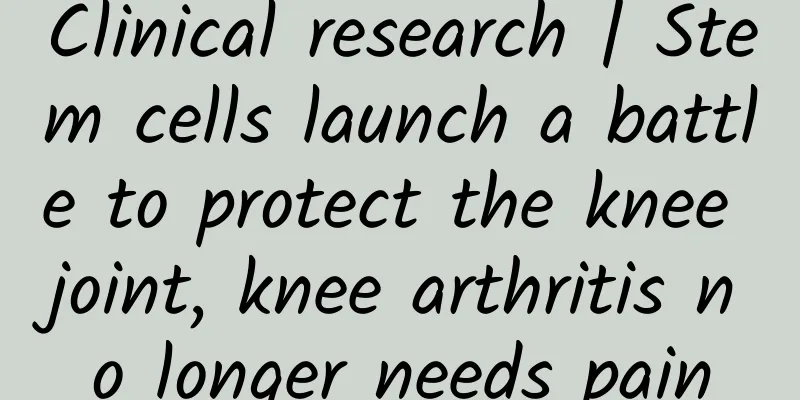Clinical research | Stem cells launch a battle to protect the knee joint, knee arthritis no longer needs pain

|
Osteoarthritis (OA) is a degenerative joint disease with a high incidence in the middle-aged and elderly population, mainly manifested as joint pain and dysfunction. Its incidence ranks among the top 10 non-communicable diseases. In China, 8.1% of people over 50 years old suffer from symptomatic knee OA, totaling more than 30 million people. The therapeutic effect of mesenchymal stem cells (MSCs) is mainly attributed to their immunomodulatory function under the regulation of inflammatory environment, and can be used to treat a wide range of degenerative and inflammatory diseases, such as ulcerative colitis, arthritis, GVHD, systemic lupus erythematosus, etc. This summary focuses on MSCs for the treatment of arthritis. This summary lists the progress of mesenchymal stem cells used in human trials to treat knee arthritis. An important factor in the diagnosis of knee osteoarthritis is the various scores: VAS mainly evaluates pain; WOMAC is used to evaluate knee arthritis in the elderly; The reliability, validity and sensitivity of Lysholm scoring of knee joint function are relatively high. 1. Preliminary study on autologous BMSCs in the treatment of knee osteoarthritis (Transplantation, 2013) Number of participants : N = 12 (no controlled study) Treatment plan: Intra-articular injection of 4*10^7 cultured and expanded mesenchymal stem cells (BMSCs). Results were tested 1 year after treatment. Research results: The knee function indicators of patients who received bone marrow mesenchymal stem cell treatment gradually improved, with the improvement rate approaching 65% to 78% within 1 year. The quality of cartilage also improved, and the area of cartilage defects in 11 patients was significantly reduced. The figure below is a summary of the study. We will not look at the complicated parts. The ideal treatment plan is a treatment that we can basically not achieve. It can be seen that the mesenchymal stem cell treatment plan is closer to the ideal treatment plan than the traditional plan. 2. Six cases of autologous BMSCs in the treatment of knee osteoarthritis (Arch Iran Med, 2012) Number of participants: N = 6 (no controlled study) Treatment plan: Intra-articular injection of 2~2.4*10^7 cultured and expanded mesenchymal stem cells (BMSCs). Results were tested 6 months and 1 year after treatment. Results: Six months after intra-articular injection of bone marrow mesenchymal stem cells, pain, functional status, and walking distance all improved. Comparison of MRI before and after treatment in three of the six patients in the treatment group showed that the treatment was very significant in improving cartilage thickness, repairing tissue extension beyond the subchondral bone, and reducing edema in the subchondral bone. The following figure (a) shows the cartilage before treatment, and (b) shows the cartilage 6 months after treatment. The arrow indicates the location of cartilage repair. 3. Intra-articular injection of two different doses of autologous BMSCs and hyaluronic acid for the treatment of knee osteoarthritis: a multicenter randomized controlled clinical trial (Phase I/II) (J Transl Med, 2016) ·Number of participants : N = 30 (randomized controlled trial) Treatment plan: Intra-articular injection of cultured and expanded 1*10^7 (low-dose group) and 1*10^8 (high-dose group) mesenchymal stem cells (BMSCs). Results were measured 3, 6, and 12 months after treatment. Results : VAS scores improved after treatment, and WOMAC scores improved after 6 months. The volume and quality of cartilage improved 12 months after treatment, and the high-dose group had a better improvement effect. The figure below shows that the VAS scores (pain index) of patients treated with mesenchymal stem cells decreased , regardless of whether they were in the low-dose group or the high-dose group:
( Arch Iran Med, 2012) ·Number of participants: N = 30 (randomized controlled trial) Treatment plan: Intra-articular injection of 4*10^7 cultured and expanded mesenchymal stem cells (BMSCs). Results were tested 8 days, 3 months, 6 months, and 12 months after treatment. Results: Compared with the control group, pain was significantly reduced, knee function index was significantly improved, and cartilage damage was significantly reduced after BMSCs treatment. As shown in the figure below, the redder the color, the worse the cartilage quality. It can be seen that before treatment (on the left), most of the cartilage was yellow, and after treatment, there was a significant increase in blue , indicating that the cartilage quality increased after mesenchymal stem cell treatment. 5. Effect of intra-articular injection of autologous BMSCs on pain and knee joint function in patients with knee osteoarthritis (Int J Rheum Dis, 2017) Number of participants : N = 61 Treatment plan: Intra-articular injection of 10 ml of non-in vitro expanded mesenchymal stem cells (BMSCs). Results were measured 1 week, 1 month, and 6 months after treatment. Research results: After 6 months, the treatment group had significantly improved knee pain and improved quality of life after mesenchymal stem cell treatment. 6. A randomized single-blind trial of bone marrow aspirate concentrate in the treatment of knee osteoarthritis (Am J Sports Med, 2017) ·Number of participants: N = 25 Treatment plan: Intra-articular injection of 5 ml of bone marrow concentrate and 10 ml of PRP. Results were measured 1 week, 1 month, and 6 months after treatment. Results: After injection of bone marrow extract concentrate, knee pain was significantly improved, but there was no significant difference compared with the saline control group. 7. Clinical trial of intra-articular injection of ADSCs for the treatment of knee arthritis (Stem Cells. 2014) Number of participants: N = 18 Treatment plan: Intra-articular injection of in vitro expanded 1*10^7 (low-dose group), 5*10^7 (medium-dose group), 1*10^8 (high-dose group), test results 1 month and 6 months after treatment. Research results: After the injection of adipose-derived mesenchymal stem cells (ADSCs), knee pain was significantly improved, and the volume and quality of cartilage increased significantly. The following figure shows that from left to right , cartilage is gradually repaired with the changes of mesenchymal stem cell treatment. 8. ADSC injection improves knee osteoarthritis symptoms (Arthroscopy, 2013) Number of participants: N = 18 Treatment plan: Intra-articular injection of 1.18*10^6 adipose-derived mesenchymal stem cells, together with PRP and arthroscopic clearance. Results were measured 1 month and 6 months after treatment. Results: WOMAC, Lysholm, and VAS scores improved after treatment. Subsequent analysis showed that the improvement in clinical and radiographic examinations was related to the number of adipose-derived stem cells injected. 9. Clinical efficacy of ADSCs in the treatment of knee osteoarthritis and secondary arthroscopy (Arthrosc, 2015) ·Number of participants: N = 30 Treatment plan: Intra-articular injection of 4.04*10^6 adipose-derived mesenchymal stem cells, together with PRP and arthroscopic clearance. Results were measured 3 months, 12 months, and 2 years after treatment. Results: Most patients showed significant improvement in all outcome measures at final follow-up. At the second arthroscopy, 14 (out of 16) had no articular cartilage degeneration, and only five patients had a worsening of the Kellgren-Lawrence score. Figure a below shows the result of arthroscopic examination before treatment, which shows that there is a defect in the cartilage. Figure b shows the treatment of adipose mesenchymal stem cells combined with PRP, and Figure c shows the result after treatment . Through mesenchymal stem cell treatment, the cartilage has been repaired.
(Am J Sports Med, 2014) Number of participants: N = 35 Treatment plan: Intra-articular injection of 3.8*10^6 adipose-derived mesenchymal stem cells, and the results will be tested approximately 24-36 months after treatment. Research results: ADSCs treatment can significantly improve knee osteoarthritis, and the higher the BMI, the worse the effect. In the following figure, AC is a 51-year-old male knee arthroscopy, and DF is a 54-year-old female knee arthroscopy. A/D is before treatment, white indicates cartilage, and light yellow indicates exposed bone. B/E is mesenchymal stem cell injection. C/F is an arthroscopic examination after treatment. 11. Infrapatellar ADSCs for the treatment of knee osteoarthritis (Knee, 2012) `Number of participants: N = 25 `Treatment plan: Intra-articular injection of 1.89*10^6 adipose-derived mesenchymal stem cells, PRP and combined arthroscopic cleaning. The results were tested about 3 months after treatment and 16 months later. `Research results: After ADSCs treatment, pain was significantly relieved and knee joint function improved. 12. Intra-articular injection of ADSC (SVF) and PRP for the treatment of osteoarthritis (J Transl Med, 2017) `Number of participants: N = 10 people `Treatment plan: Intra-articular injection of adipose-derived matrix components ADSVF and PRP, and test results 1 week, 1 month, 6 months, 1 year, 1.5 years, and 2 years after treatment. `Study results: After treatment, WOMAC scores also improved after 2 years. Walking distance in 6 minutes also increased significantly. Cartilage volume increased in 60% of patients. As shown in the above picture, the left picture is before treatment, and the right picture is after treatment. The white "+" indicates cartilage thickening. 13. Phase I dose-escalation trial of ADSCs in the treatment of severe knee osteoarthritis (Stem Cells Transl Med, 2017) `Number of participants: N = 18 people `Treatment plan: Intra-articular injection of 2*10^6 (low dose), 10*10^6 (medium dose), and 50*10^6 (high dose) adipose tissue stromal cell SVF, and the results will be tested about 6 months after treatment. `Research results: After ADSVF treatment, pain was significantly relieved and no adverse reactions were found. The following figure is a comparison of MRI before and after treatment. As before, the bluer the color, the better the cartilage quality. It can be seen that the cartilage quality is significantly improved after mesenchymal stem cell treatment. 14. Clinical observation of arthroscopic SVF injection in the treatment of microfractures in osteoarthritis (Stem Cells Transl Med, 2016) ·Number of participants : N = 30 Treatment plan: Intra-articular injection of 1*10^6 ADSCs mixed with SVF and PRP, and test results approximately 6 months, 12 months, and 18 months after treatment. Results: Compared with the control group, the treatment group had lower WOMAC scores and higher VAS and Lysholm scores, indicating that knee pain and function were improved. 15. Enhancement of cartilage formation ability of ADSCs and BMSCs in an in vitro osteoarthritis model (J Cell Physiol, 2016) Number of participants: N = 6 Experimental plan: 2.5*10^5 ADSCs and BMSCs were cultured in 1 ml of culture medium and observed after 1 month. Evaluation indicators: cartilage-specific genes | inflammatory factor expression ·Research results: Adipose-derived mesenchymal stem cells (ADSCs) have a stronger ability to differentiate into cartilage than bone marrow-derived mesenchymal stem cells (BMSCs). Disclaimer: The content comes from the Internet, and the copyright belongs to the original author. This article is for popular science knowledge, for information exchange purposes only, not for commercial purposes. If it involves the content, copyright and other issues, please contact us to delete it. END |
<<: These signals of "over-fatigue" are alarms from the body, so you must take them seriously!
>>: 2023 Medical Science Popularization - Liver Cyst
Recommend
What should I do if I catch a cold during confinement?
Many women have shared their experiences of confi...
[Health Lecture] If it hurts, just speak out loud!
In order to ensure the popularization effect of l...
How to prevent recurrence of gynecological inflammation?
Women are generally familiar with gynecological i...
How to distinguish sinusitis from rhinitis? What is the difference between them?
How to distinguish between sinusitis and rhinitis...
Minimally invasive re-ligation surgery
Bilateral tubal ligation is a contraceptive surgi...
Squeeze out the water and breast hyperplasia will be cured
The breast is a very important organ of women. No...
When is the best time to perform hysteroscopy?
The time for cervical examination should comply w...
Don’t panic if you find nodules during a physical examination! But you should avoid these 5 foods
In recent years, the frequency of "nodules&q...
Does sodium bicarbonate treat vaginitis?
Sodium bicarbonate is a weak alkaline substance. ...
What foods should not be eaten when having breast cysts
If patients with breast cysts cannot abide by the...
What to do if you have less menstruation
Menstruation is an important feature that disting...
How many days does it take to stop milk production and what are the methods to stop breasts from becoming hard?
It is said that breast milk is the most ideal foo...
What should women do if they have too much body hair?
Generally speaking, male friends have more and th...
comScore: 2011 Global Social Report – Top 10 must-know insights about social networks
Social networking is a global phenomenon, and it i...









